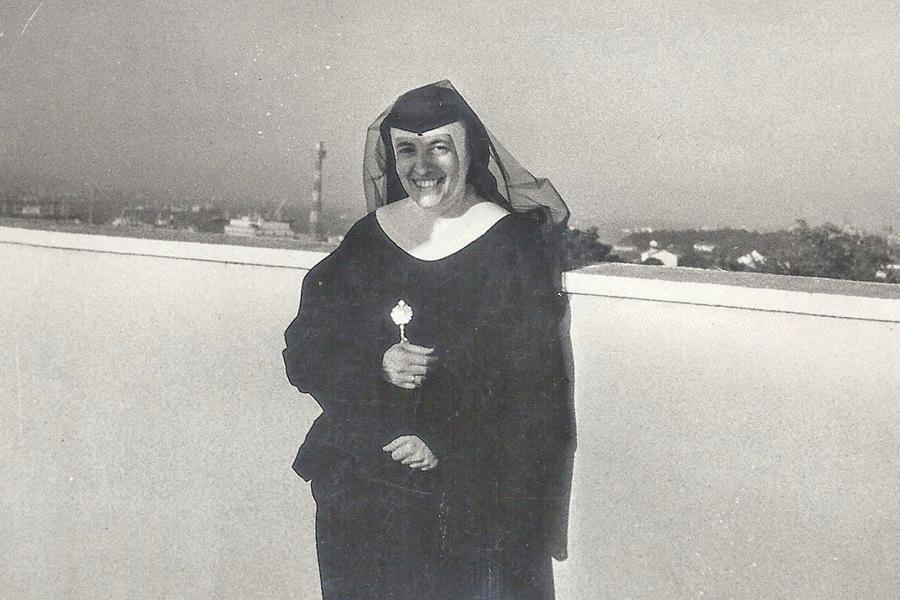"I have always gone where there was a woman who needed me." On the other end of the phone, the broken voice of Victoria de la Cruz resonated like an echo of time; like the explosion of a minefield of endless memories. At 108 years old, she struggled to remember what she had for breakfast that morning, but vividly recounted thrilling episodes of a movie-like past. The protagonist was a nun from Malaga who arrived in imperial Japan and dedicated all her energy to rescuing dozens of women and girls from the darkest backyards of the post-war era.
This call took place in 2016. Two years later, Victoria passed away at the age of 110 in Tokyo, at the Casa Alegría of the Adorers of Kitami, one of the seven houses that the congregation founded in Madrid in 1856 has in the Asian country to liberate women oppressed by prostitution.
Victoria, as an Adorer missionary, spent decades touring brothels, industrial areas, roadside ditches and geisha houses throughout Japan, trying to help vulnerable women who were victims of trafficking. Those she managed to rescue, convincing them to go with her to a safe place, she took them along with her colleagues to shelters where social workers offered them protection and training so they could move forward.
During a couple of phone conversations that Victoria had with the journalist who wrote these lines between 2016 and 2017, the nun also explained how, after the atomic bomb in Hiroshima and Nagasaki, she would go out at night without her habit, even pretending on some occasions to be a Western sex worker, to investigate how the Yakuza network operated, the famous Japanese crime syndicate that sold orphaned girls from the bomb to brothels and geisha houses, where they were forced to dance to entertain clients.
On this August 6, on the 80th anniversary of the bombing of Hiroshima, we recall the story of the nun from Malaga who saved survivors of a nuclear explosion that left approximately 140,000 dead, 80,000 immediately and another 60,000 people who later died from burns and radiation-related illnesses .
Victoria, the second of nine siblings, arrived in Japan in 1936. "It was a two-month journey by boat and I suffered a lot from leaving my family behind. But I also felt good because I was convinced that I had a mission to help many people," she recounted. She had been in Tokyo for three years when the Japanese aviation attacked Pearl Harbor. During the following six years of war, she was sheltered, along with the sisters of her community, in the mountains of Karuizawa, enduring cold and surviving on rice.
After the atomic bomb Little Boy dropped from a US B-29 plane devastated Hiroshima (140,000 dead), and three days later a second bomb hit Nagasaki, killing another 74,000 people, Japan surrendered on September 2, 1945. A few months later, Victoria and the rest of the Adorers were able to leave their mountain refuge and moved south to Yokohama. There, collaborating with local agents and humanitarian organizations, they began to search for the orphaned survivors lost from the bombing. Some of them had been kidnapped by the mafias.
Researchers estimate that there were about 2,700 school-age children who were orphaned in 1945 after the atomic bombing, the vast majority without any relatives to care for them. Around 700 were placed in orphanages. But the rest ended up on the streets, wandering around Hiroshima station, sleeping under bridges, in the ruins of burned buildings, or in air-raid shelters. One of these children, Shoso Kawamoto, was 11 years old when he lost his parents and siblings. He was able to survive because, before the attack, he was evacuated with other students to a temple 50 kilometers from the city center.
Kawamoto, who passed away in 2022, spent decades recounting how Yakuza gangsters took orphaned children like him off the streets. They offered them a bed and a meal, but also put them to work cleaning shoes, preparing porridge in street stalls, or selling methamphetamine and cigarettes made from the butts discarded by US soldiers. In the case of many girls, according to Kawamoto, they would suddenly disappear from the shelters opened by the Yakuza. "In our center, there were over 300 orphaned girls. They disappeared one by one until none were left," Kawamoto recalled.
Many of these girls ended up sold to brothels or geisha houses scattered throughout Japan. This is where the habitless nuns who have been rescuing women from trafficking for two centuries came into play; Adorers like the Spanish nun, who patrolled the prostitution hotspots in Japan with old vans, confronting the mafias and offering an alternative to the victims.
Victoria de la Cruz was honored by the Japanese government for protecting and rescuing many women, from the Hiroshima orphans to those known as "comfort women", young women from other Asian countries who had been abducted by the Japanese imperial army and forced to work in brothels frequented by the military during World War II.
